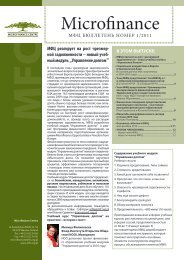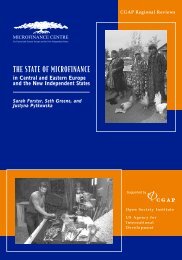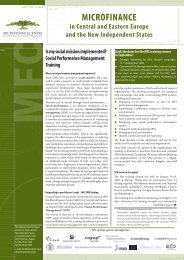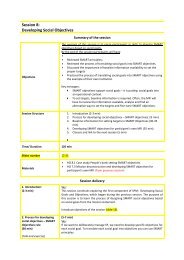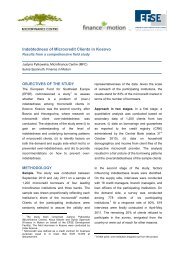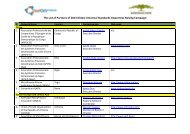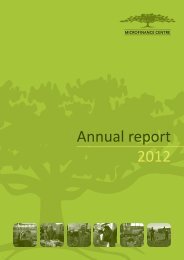Value Chains research report Tajikistan final - Microfinance Centre
Value Chains research report Tajikistan final - Microfinance Centre
Value Chains research report Tajikistan final - Microfinance Centre
You also want an ePaper? Increase the reach of your titles
YUMPU automatically turns print PDFs into web optimized ePapers that Google loves.
facilities, in<br />
bulk, without<br />
crates<br />
arrive (crates and sawdust are not as<br />
easily available in spring as during the<br />
harvest season)<br />
Lemons are usually stored by the growers. Sellers do not risk putting their fruit in the<br />
storage due to the following reasons:<br />
• Uncertainty that the lemons were not damaged during picking and transportation;<br />
• Uncertainty whether too much fertilizer or plant protecting agents (including<br />
fertilizers) was used, which affects the product’s shelf life;<br />
• Uncertainty whether too much chemicals were used to wash the fruit after picking<br />
(usually detergent solutions are used).<br />
Lemons are very difficult to store. In the first two months, up to 30% of the fruit can be<br />
lost due to rotting or shrinkage. Those who do take the risk and store their lemons<br />
usually win and get a good profit margin. In 2009, lemons in Kumsangir were priced at 3<br />
Somoni a kilo, while in July they were sold after storage at 40 Somoni per kilogram at<br />
the markets in Dushanbe, or 30 Somoni at the farm level. This difference of over 1000%<br />
covers and justifies the investment into this activity.<br />
Export of lemons<br />
Lemons of <strong>Tajikistan</strong> are mostly demanded in countries of Central Asia, Russia and<br />
these countries have become the main customers (See Table 37). Lemons inside of the<br />
country are being distributed in Khujand, Dushanbe, and Tursunzade. Export of lemons<br />
to Uzbekistan (Denav, Tashkent and Namangan), Kazakhstan, Kirghizstan and Russia<br />
is going through Tursunzade border (Sari Osiyo). There is a large amount of contraband<br />
lemons which is being exported illegally. Farmers sell lemons for 4 somoni per kg, the<br />
cost of lemons in Dushanbe is 10 somoni per kg and in the Uzbekistan market it is 20<br />
somoni per kg.<br />
Table 37: Lemon exports from <strong>Tajikistan</strong> (in tonnes)<br />
2006 2007 2008 2009 2010<br />
Export of Lemons (in 229 36 417 264 628<br />
total)<br />
Kazakhstan 34 - 108 76 21<br />
Kirghizstan - - 15 18<br />
Russia 160 26 2 1 17<br />
Uzbekistan 9 - 228 187 552<br />
Turkmenistan - - 64<br />
Afghanistan 26 10 -<br />
Pakistan 20<br />
Source: State Statistic Agency of <strong>Tajikistan</strong><br />
The results of the current tables 37 show that most lemons in <strong>Tajikistan</strong> are consumed<br />
by Central Asia (inside country and in export). Export of lemons increased in 2010 with<br />
81




